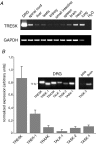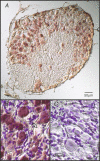TRESK two-pore-domain K+ channels constitute a significant component of background potassium currents in murine dorsal root ganglion neurones
- PMID: 17962323
- PMCID: PMC2375503
- DOI: 10.1113/jphysiol.2007.145649
TRESK two-pore-domain K+ channels constitute a significant component of background potassium currents in murine dorsal root ganglion neurones
Abstract
TRESK (TWIK-related spinal cord K(+) channel) is the most recently identified member of the two-pore-domain potassium channel (K(2P)) family, the molecular source of background potassium currents. Human TRESK channels are not affected by external acidification. However, the mouse orthologue displays moderate pH dependence isolated to a single histidine residue adjacent to the GYG selectivity filter. In the human protein, sequence substitution of tyrosine by histidine at this critical position generated a mutant that displays almost identical proton sensitivity compared with mouse TRESK. In contrast to human TRESK, which is specifically located in spinal cord, we detected mouse TRESK (mTRESK) mRNA in several epithelial and neuronal tissues including lung, liver, kidney, brain and spinal cord. As revealed by endpoint and quantitative RT-PCR, mTRESK channels are mainly expressed in dorsal root ganglia (DRG) and on the transcript level represent the most important background potassium channel in this tissue. DRG neurones of all sizes were labelled by in situ hybridizations with TRESK-specific probes. In DRG neurones of TRESK[G339R] functional knock-out (KO) mice the standing outward current IK(so) was significantly reduced compared with TRESK wild-type (WT) littermates. Different responses to K(2P) channel regulators such as bupivacaine, extracellular protons and quinidine corroborated the finding that approximately 20% of IK(so) is carried by TRESK channels. Unexpectedly, we found no difference in resting membrane potential between DRG neurones of TRESK[WT] and TRESK[G339R] functional KO mice. However, in current-clamp recordings we observed significant changes in action potential duration and amplitude of after-hyperpolarization. Most strikingly, cellular excitability of DRG neurones from functional KO mice was significantly augmented as revealed by reduced rheobase current to elicit action potentials.
Figures






Similar articles
-
Chemically Modified Derivatives of the Activator Compound Cloxyquin Exert Inhibitory Effect on TRESK (K2P18.1) Background Potassium Channel.Mol Pharmacol. 2019 Jun;95(6):652-660. doi: 10.1124/mol.118.115626. Epub 2019 Apr 12. Mol Pharmacol. 2019. PMID: 30979812
-
TREK-2 (K2P10.1) and TRESK (K2P18.1) are major background K+ channels in dorsal root ganglion neurons.Am J Physiol Cell Physiol. 2006 Jul;291(1):C138-46. doi: 10.1152/ajpcell.00629.2005. Epub 2006 Feb 22. Am J Physiol Cell Physiol. 2006. PMID: 16495368
-
Activation of TRESK channels by the inflammatory mediator lysophosphatidic acid balances nociceptive signalling.Sci Rep. 2015 Jul 30;5:12548. doi: 10.1038/srep12548. Sci Rep. 2015. PMID: 26224542 Free PMC article.
-
Properties, regulation, pharmacology, and functions of the K₂p channel, TRESK.Pflugers Arch. 2015 May;467(5):945-58. doi: 10.1007/s00424-014-1634-8. Epub 2014 Nov 5. Pflugers Arch. 2015. PMID: 25366493 Review.
-
The Special One: Architecture, Physiology and Pharmacology of the TRESK Channel.Cell Physiol Biochem. 2022 Nov 25;56(6):663-684. doi: 10.33594/000000589. Cell Physiol Biochem. 2022. PMID: 36426390 Review.
Cited by
-
Amplified cold transduction in native nociceptors by M-channel inhibition.J Neurosci. 2013 Oct 16;33(42):16627-41. doi: 10.1523/JNEUROSCI.1473-13.2013. J Neurosci. 2013. PMID: 24133266 Free PMC article.
-
Regulating excitability of peripheral afferents: emerging ion channel targets.Nat Neurosci. 2014 Feb;17(2):153-63. doi: 10.1038/nn.3602. Epub 2014 Jan 28. Nat Neurosci. 2014. PMID: 24473263 Review.
-
Temperature sensitivity of two-pore (K2P) potassium channels.Curr Top Membr. 2014;74:113-33. doi: 10.1016/B978-0-12-800181-3.00005-1. Curr Top Membr. 2014. PMID: 25366235 Free PMC article. Review.
-
The LQLP calcineurin docking site is a major determinant of the calcium-dependent activation of human TRESK background K+ channel.J Biol Chem. 2014 Oct 24;289(43):29506-18. doi: 10.1074/jbc.M114.577684. Epub 2014 Sep 8. J Biol Chem. 2014. PMID: 25202008 Free PMC article.
-
Aristolochic acid, a plant extract used in the treatment of pain and linked to Balkan endemic nephropathy, is a regulator of K2P channels.Br J Pharmacol. 2016 May;173(10):1639-52. doi: 10.1111/bph.13465. Epub 2016 Apr 5. Br J Pharmacol. 2016. PMID: 26914156 Free PMC article.
References
-
- Augustin M, Sedlmeier R, Peters T, Huffstadt U, Kochmann E, Simon D, Schoniger M, Garke-Mayerthaler S, Laufs J, Mayhaus M, Franke S, Klose M, Graupner A, Kurzmann M, Zinser C, Wolf A, Voelkel M, Kellner M, Kilian M, Seelig S, Koppius A, Teubner A, Korthaus D, Nehls M, Wattler S. Efficient and fast targeted production of murine models based on ENU mutagenesis. Mamm Genome. 2005;16:405–413. - PubMed
-
- Baumann TK, Burchiel KJ, Ingram SL, Martenson ME. Responses of adult human dorsal root ganglion neurones in culture to capsaicin and low pH. Pain. 1996;65:31–38. - PubMed
-
- Baumann TK, Chaudhary P, Martenson ME. Background potassium channel block and TRPV1 activation contribute to proton depolarization of sensory neurones from humans with neuropathic pain. Eur J Neurosci. 2004;19:1343–1351. - PubMed
-
- Bayliss DA, Sirois JE, Talley EM. The TASK family: two-pore domain background K+ channels. Mol Interv. 2003;3:205–219. - PubMed
MeSH terms
Substances
LinkOut - more resources
Full Text Sources
Other Literature Sources
Molecular Biology Databases
Research Materials

